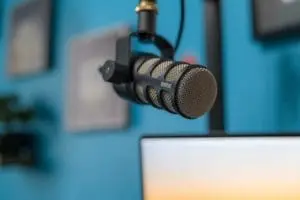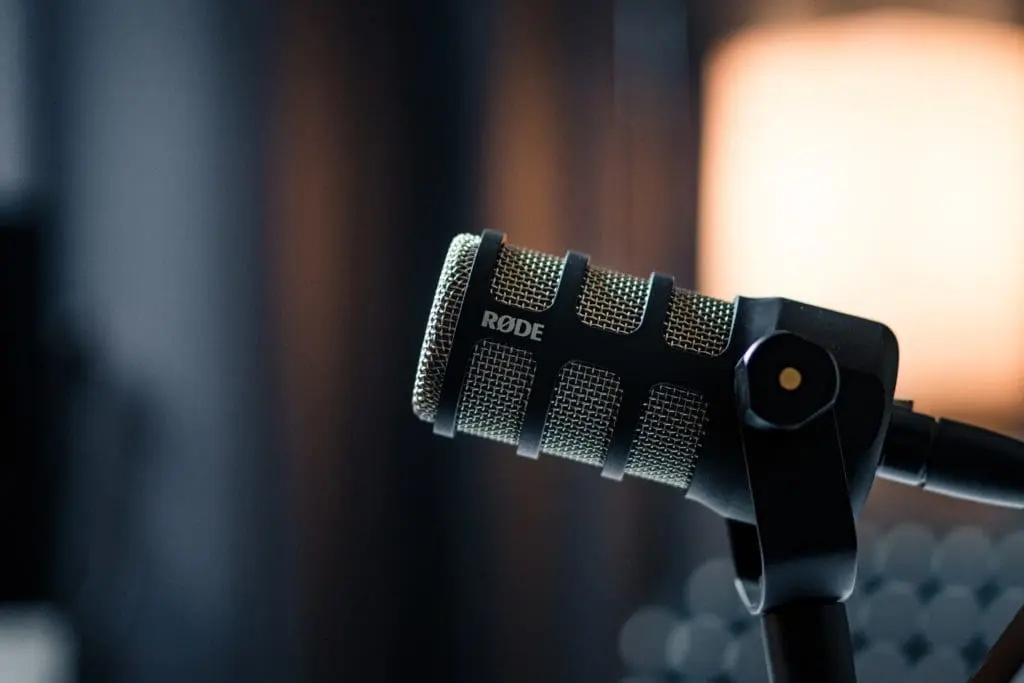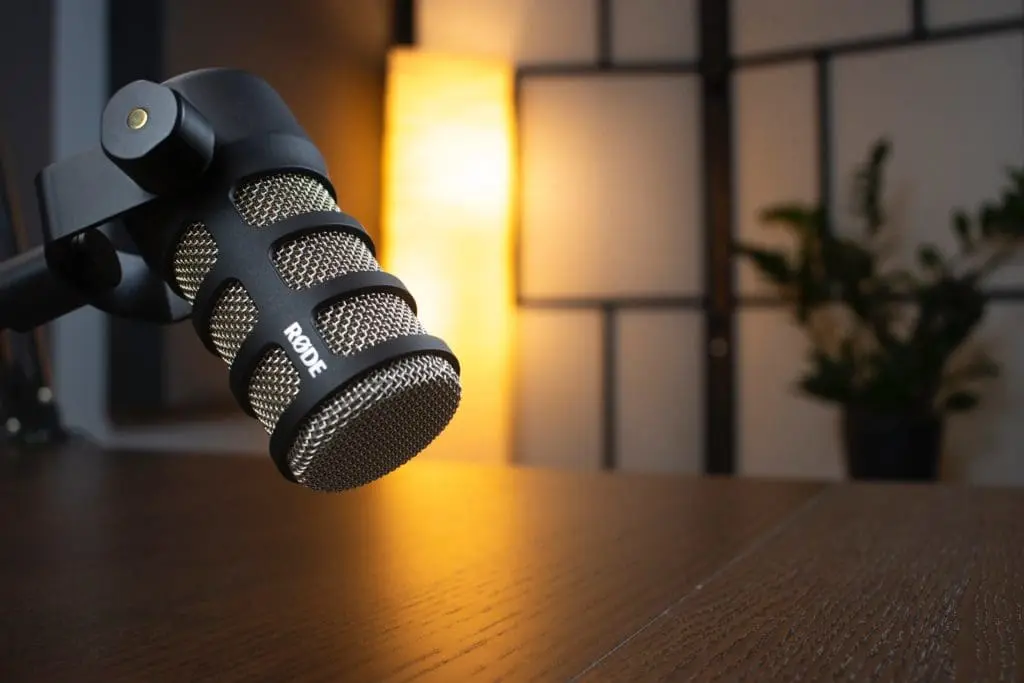
The Rode PodMic is quickly becoming the go-to microphone for podcasters who care about audio quality. Let’s be real—your mic can make or break your sound, and in a crowded field of over 4 million podcasts, ‘just okay’ won’t cut it.
That’s why we’re honing in on this specific mic.
If you’re after crisp audio, fewer editing headaches, and a price tag that won’t make you wince, you’ve landed in the right spot.
This is a comprehensive review of the Rode PodMic, where we’ll break down its features, performance, and why it could be the pivotal piece that your podcast setup needs
Before we get to it, we want to let you know that we’re Amazon Associates, and may earn a commission if you purchase something through the links in this article. This doesn’t cost you anything extra.
We review all products independently and at our own will. We think the Rode PodMic is rad and wanted to share it with you.
Rode PodMic Price
Let’s get straight to business.
Unless you’re Kylie Jenner and you’re starting a podcast, price is probably one of your top priorities in choosing a mic.
Depending on the format of your podcast, you may need several microphones, if you’re hosting multiple guests at once. If you’re laying out a few hundred bucks per mic, the total cost can add up quickly.
Fortunately, the Rode PodMic’s price tag isn’t out of the average person’s budget. Clocking in at under $120, it’s definitely not the cheapest microphone on the market, but it’s a lot more affordable than many alternatives in its class.
What’s more, a hundred bucks isn’t a massive investment to make for a piece of equipment that’s pivotal to the quality of your offering.
And spoiler alert, the Rode PodMic could seriously upgrade the quality of your audio. The price on this podcast microphone is a serious steal when you consider what it’s capable of.
Rode PodMic Build Quality
The first thing you’ll notice when you handle the Rode PodMic is its sheer weight and sturdiness.
Clocking in at 937 grams, which is roughly 2 pounds, the Rode PodMic definitely feels like it’s built to last. An all-metal body gives this podcast microphone a high-quality look and feel.
Not only is it heavy in the hand, but the metal grill has almost zero give, which is just what you want in a microphone. In short, this little beast of a microphone feels incredibly well put together.
If you compare the body and housing to most dynamic mics on the market today, the housing quality in the Rode PodMic is definitely one of, if not the, highest, of microphones in the same class.
Rode PodMic Specs
This solid little dynamic mic definitely packs a punch on the specs front. It has a cardio polar pattern, which is what you want for podcasting. Additionally it has a frequency response of 20 hertz to 20 kilohertz.
This ensures it captures the full range of the human voice.
It also has an attached mounting system featuring 5/8 and 3/8 threading and built-in articulation. The attached mounting system is ideal for portable podcasting setups and studios alike.
When podcasting you want to be hands free, so you can look at your notes or laptop. Thus, I recommend pairing the PodMic with the Rode PSA1 boom arm.
If you’ve done any research on podcasting microphones, you’ll know that the PodMic specs made it inherently designed for capturing speech. Thanks to this, as well as its finely-tuned default settings, you can record podcast-grade audio right off the bat with a minimum of post-production tweaking and cleaning up.
Built-in Pop Filter
Another standout feature that the Rode PodMic has hidden in its robust body is a built-in pop filter.
If you’re new to mics, pop filters catch and eradicate explosive speech noises. And no, we’re not talking about that heated-up guest that’s shouting down their microphone.
Well, maybe a little bit—but pop filters are designed to catch and soften the explosive sounds that are part of normal speech.
“P”, “K”, and “T” are the main culprits. Have you ever listened to a poor-quality audio recording where every “p” and “k” that comes from the speaker causes a popping sound and makes you feel like they’re spitting into the microphone?
That’s what we’re talking about.
If you don’t want your audio to sound like this, then you need a pop filter. Pop filters usually look like small disks or rectangles with a mesh center.
The mesh grille on the PodMic disperses the audio and helps to soften and spread out explosive syllables, making your voice sound the best it can.
Sturdy as Can Be
If you hate cheap feeling plastic mics, then this is the podcasting microphone for you. As we said above, with its ultra-sturdy housing the Rode PodMic is built to last and should see you through hundreds of shows with minimal wear and tear.
Rode PodMic Is Compact
Although somewhat on the heavy side, thanks to its durable housing, the Rode PodMic is incredibly compact for its capabilities, Measuring only 6 cm across and 12 cm in length, it is far smaller than other pro-level mics of this caliber.
Thanks to this, the PodMic is a great travel-ready option if you need to hit the road with your show.
Rode PodMic Use Cases
As you can probably tell from the PodMic specs, this robust podcast mic, is just that, a podcasting microphone.
With this mic, Rode has specifically set out to design a microphone that fully caters to a podcaster’s needs, while not breaking the bank.
Everything from its sensitivity to its impedance, built-in pop filter, and standard settings screams podcast setup. Thanks to this, you can whip this baby out of the box, connect it, and be recording top-notch audio, quickly.
Rode PodMic Performance
Like we said above, the Rode PodMic is specifically designed to deliver in podcast settings—but does it?
Fortunately, since it’s not a new release, the PodMic has been put through its paces since it came on the market. And the resounding consensus is, yes, it really does stand out for delivering premium podcasting audio capabilities.
For instance, even if your guest leans away up to 20 degrees off-axis, the tone won’t change dramatically. Thanks to this, you can position the Rode PodMic close to a wall or other solid surface and the mic will still yield excellent capture.
Another reason why the Rode PodMic is so superbly suited to podcasting is that the mic capsule skillfully rejects microphone bleed. This is ideal for podcast settings and makes edits much more flexible.
Nothing is worse than trying to mix a podcast that’s full of microphone bleed! Even seasoned audio engineers struggle with it.
Rode PodMic Pros and Cons
Pros
- Background Noise Reduction: Exceptional at minimizing background noise.
- Tuned for Spoken Word: Designed specifically for podcasting and interviews.
- Minimal Post-Processing: Records quality audio that requires minimal processing.
- Clean, Rich Sound: Delivers professional-level audio quality.
- Sturdy Build: Made with durable materials, built to last.
- Compact Size: Measures only 6 cm x 12 cm, making it travel-friendly.
Cons
- Limited Versatility: Not ideal for multi-purpose use like music recording.
- No Onboard Settings: Adjustments require external equipment like the Rodecaster Pro or a DAW.
- XLR Connection Only: It doesn’t support USB, so you’ll need an audio interface to connect it to your computer.
- Requires Good Preamp: To get the best sound quality, you’ll need a decent preamp, which could be an additional cost.
The Latest Additions: Rode PodMic USB
We’re always on the hunt for the latest and greatest in podcasting gear, and we couldn’t wait to share this update with you. The Rode PodMic USB is the new kid on the block, and it’s bringing some trailblazing features that we think you’ll love.
Meet Rode PodMic USB
This newer version takes everything you loved about the original PodMic and adds a layer of versatility and convenience that’s hard to ignore.
Whether you’re podcasting, streaming, or recording voiceovers, the PodMic USB is designed to deliver broadcast-quality audio in a variety of settings.
Versatile Connectivity
One of the standout features of the PodMic USB is its dual connectivity options. Unlike the original PodMic, which only offered XLR output, the USB version provides both XLR and USB outputs.
This means you can connect it to a traditional audio interface or mixer, or plug it directly into your computer for a quick and easy setup.
Additionally, Rode PodMic USB has a built-in headphone output. Plug your headphones in and BOOM, you’re monitoring your audio in real time with no latency.
Exceptional Sound Quality
The PodMic USB isn’t just versatile; it also delivers on the audio front.
It features RØDE’s ultra-low-noise, high-gain Revolution Preamp and powerful APHEX digital signal processing. This ensures that your recordings will have some oomph.
We could all use some oomph, right?
Mobile Compatibility
Another upgrade is its compatibility with iOS and Android devices. This makes the PodMic USB an excellent choice for those who need a high-quality, portable podcasting or streaming solution.
Built To Last
Just like its predecessor, the PodMic USB is constructed from high-grade components and is incredibly rugged. It even comes with a five-year warranty, ensuring that it’s a long-term investment for your audio projects.
Rode PodMic vs Rode PodMic USB
While the original PodMic is a fantastic microphone in its own right, the PodMic USB offers several features that set it apart.
The dual connectivity options and mobile compatibility make it a more versatile choice for today’s content creators.
Additionally, the advanced sound processing capabilities mean you’re getting an all-in-one solution that’s ready to tackle any audio challenge you throw at it.
By adding the PodMic USB to your audio arsenal, you’re not just getting an updated version of the PodMic; you’re getting a more flexible, feature-rich microphone that’s equipped to meet the demands of modern content creation.
The White Rode PodMic
There’s also a White Rode PodMic available. Rode designed the PodMic in white to complement their White Collection. The white version of this microphone has the exact same specs as the original. The color change is strictly for aesthetic purposes—or as the kids say, “vibes.”
The White Collection is a limited-edition series of some of Rode’s most popular audio equipment, reimagined in a sleek white finish. This collection offers creators the opportunity to enhance their setups with a fresh, clean aesthetic.
The collection includes:
- A white RodeCaster Pro
- Several white microphones
- A white RodeCaster Duo
- And more
Check out the full White Collection to see all the products in this stylish lineup.
Why Rode P odMics Are Your New Best Friends
odMics Are Your New Best Friends
Let’s get down to brass tacks. The Rode PodMic and its new sibling, the PodMic USB, are pretty much the Swiss Army knives of podcasting mics.
If you’re looking for crisp audio, durability, and a price that won’t have you eating ramen for a month, these mics are your jam. The original PodMic offers a sturdy build and exceptional sound quality, specifically tuned for spoken word.
Now, if you’re eyeing something with a bit more versatility, the PodMic USB steps it up a notch. It offers dual connectivity options—XLR and USB—making it a breeze to set up, whether you’re a traditionalist or a digital native.
Plus, it’s compatible with mobile devices, so it’s as portable as you are.
Both mics are built like tanks, so durability is a non-issue.
The only real downside?
They’re not multi-purpose mics.
But hey, they’re designed to do one thing exceptionally well—capture killer podcast audio. So, if you’re in the podcast game to win it, investing in a Rode PodMic is pretty much a no-brainer.
It’s the kind of gear that lets you focus on content, knowing your audio quality is in good hands.
Follow The Podcast Haven On Social Media
More Blog To Teach Your How To Create Better Content
- How To Choose the Right Podcast Format: The Key To Consistency and Engagement
- The Best Headphones For Editing Podcasts and YouTube Videos
- The Best Podcast Recording Software: Our Eight Favorite DAWs
- How To Choose Your Podcast Length
- Best Podcast Microphones For 2025: Our Top 10


